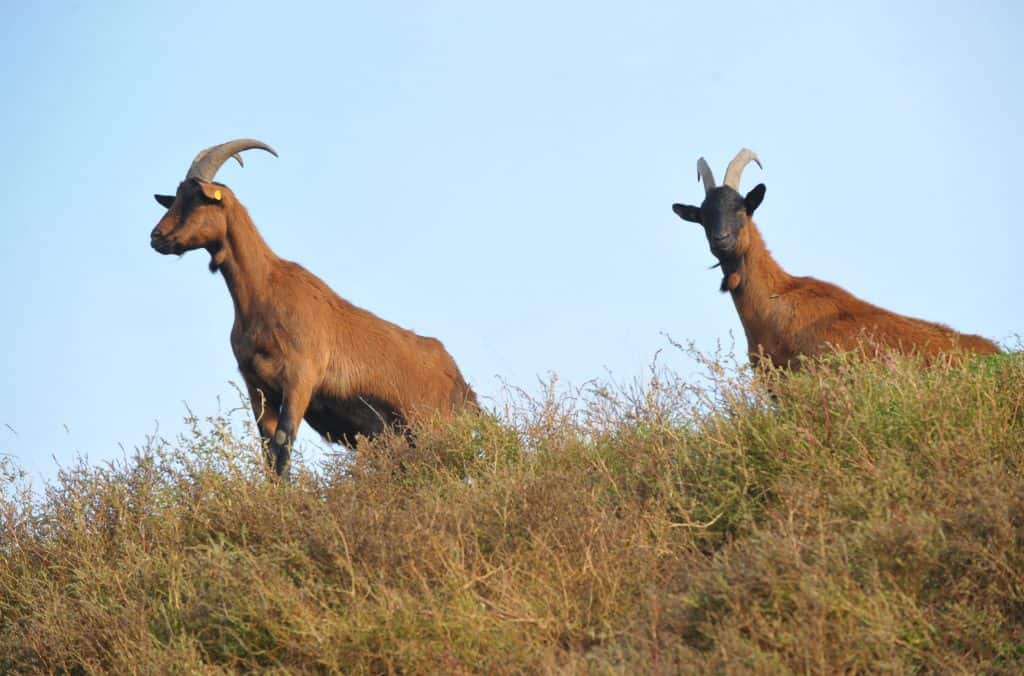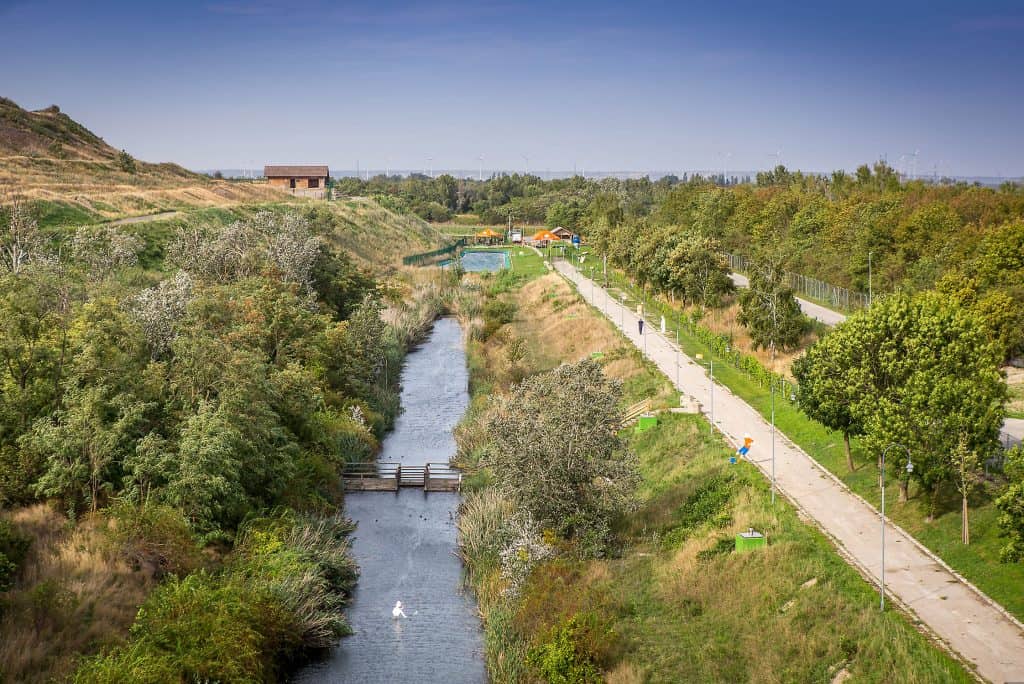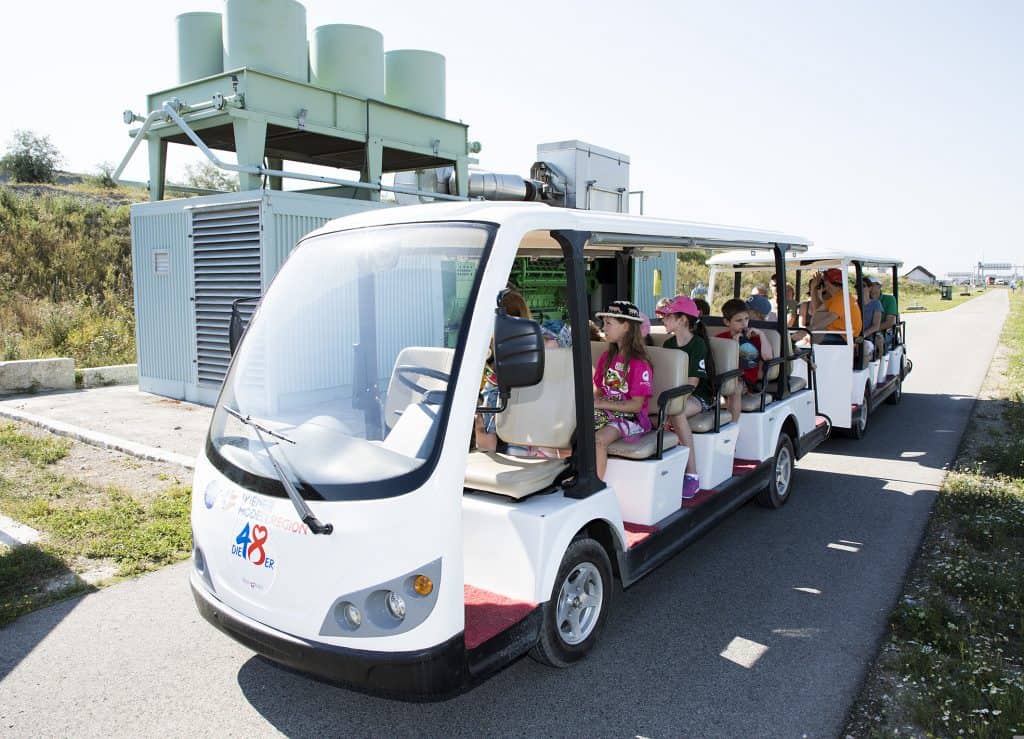On a Sunday in early May, thousands of people from all over Vienna gathered in the city’s northeastern corner for a day in the sun, enjoying music performances, candy floss, guided walks around the verdant surroundings, and the chance to spot a mountain goat called Hellgirl. The location? Austria’s largest landfill.
Rautenweg has come a long way from its humble beginnings as a gravel pit filled with untreated waste. While other places struggle with overflowing, environmentally destructive landfills, Vienna has created one that is in many respects a net-positive for the environment: It supports biodiversity, has helped endangered species rebound, heats hundreds of thousands of surrounding homes, and offers free educational tours of its lush location to boot.
Its most famous residents are a herd of Pinzgau goats such as Hellgirl, a species of mountain goat from the Salzburg region of Austria that was critically endangered as recently as the early 1990s. When four of them were settled at Rautenweg’s “trash mountain” (or “Beag aus Mist” in Viennese) in 1994 to serve as eco-friendly lawnmowers, only around 200 such animals were left in Austria. Since then, however, around as many kids have been born at the landfill alone, most of which have subsequently been reintroduced to the wild.

Barring regular health checks and the introduction of a buck at breeding season, the goats are left to their own devices, free to roam the 150-acre landfill at their leisure.
“They’re self-sufficient,” says Herbert Diesenreiter, head of landfill construction at Rautenweg, and now, the landfill’s unofficial goat herder. “We just occasionally give them treats and I do a sight-check every day to make sure they’re all there and uninjured.”
If one of the vehicles at work on the landfill finds its way blocked by a goat, adds Diesenreiter, there’s no question about what happens next: “The goats always have right of way.”
While nature isn’t hard to come by in Vienna — half the city is covered by green areas — the landfill’s steppe-like terrain, kept in check by the goats’ voracious appetites, attracts species that prefer its dry, grassy environment, something that has otherwise been all but lost in the region.
The make-up of Rautenweg’s unique landscape has been determined in large part by decades of urban waste policy. In response to steep increases in waste volumes in the 1960s, Vienna started incinerating its trash, channeling the heat generated into the city’s district heating system. Waste separation was introduced in the 1980s. Today, the controlled burning process in the city’s four incinerators reduces Vienna’s waste to about 10 percent of its original volume, providing heating and hot water to up to 400,000 Viennese households in the process, depending on seasonal demands.

In part thanks to this comprehensive waste-to-energy system, Vienna is the only major city in the world that treats and deposits its residual waste entirely within city limits.
Since 2009, only ash and slag from non-recyclable waste can be deposited on Rautenweg. Once metals are removed from the material after incineration, sand, water and cement are added to the mix and the resulting concrete — up to 200,000 tonnes each year — is deposited on Rautenweg’s landfill in terraces. Three meters of soil are added on top, allowing nature to take its course, and the upshot is a green 40-meter-high hill — the highest in the district — that is slated to grow another 35 meters by 2065.
Goats aside, these conditions have attracted the crested lark, which is protected in Vienna, as well as dozens of other animal species, including rabbits, the occasional deer, and a wide variety of insects and butterflies. Especially dry areas are home to the locally endangered bur medick plant, as well as buckthorn, various species of thistle and rose, mullein, delphinium, and countless other plants that turn Rautenweg into a riot of color every summer.
There are also a couple of sheep that were recently introduced on a trial basis. “We have to see how they get along with the goats,” explains Ingrid Pirgmayer, who is guiding me and a dozen others on a walking tour of Rautenweg as she points out its flora and fauna. The tour takes us past an enclosure housing a dozen or so chickens that provide the occasional omelet for the landfill’s employees.
Crushed by negative news?
Sign up for the Reasons to be Cheerful newsletter.“[Rautenweg] is certainly an unusual sight on the edge of a large metropolis,” says Dr. Konrad Fiedler, head of botany and biodiversity research at the University of Vienna. “The moment such areas are given over to nature and only lightly managed … a space is created. And space that isn’t in intensive use is what’s most lacking in terms of biodiversity in urban areas. Plants and animals can settle and create ecosystems that are of course not comparable to the diversity of Austrian conservation hotspots, but are certainly rare for a city with almost two million inhabitants.”
While the novelty of a green landfill and the possibility of spotting the Pinzgau goats is what attracts families and tourists to Rautenweg when it opens for visitors between May and October each year, the site’s tranquil appearance belies the complex and innovative technical work that goes into creating and maintaining it.
Easy to spot among the grass, some 140 bright yellow gas wells are still harvesting methane created by waste disposed before 2009. The gas is turned into electricity and sent into the city’s grid, providing power for around 1,000 households, while the heat created by the process is sent directly to TierQuarTier, the city’s animal shelter across the street.

Then there’s the placid stream that the ducks are lazily swimming in, which is noticeably lower than the water level beyond the landfill boundaries. In the 1980s, contamination of surrounding groundwater from the landfill prompted the development of an innovation known as the Viennese Chamber System. The landfill was surrounded by two rings of leak-proof walls extending 40 meters into the ground and separated into 49 chambers with water pumps, so the water level inside the landfill is kept below the local water table and cannot spill into the surroundings.
Despite world-class innovations in the field of waste management, waste generation remains a problem in Austria. While 58 percent of waste is recycled or composted, and 38 percent processed in waste-to-energy systems, with 585 kilograms of municipal waste per capita Austrians continue to score above the EU average.
To address this issue, MA48, the municipal department for waste management in Vienna, has a number of community outreach programs, including free tours of the city’s landfill and incineration plants, a popular second-hand store, a hotline for any waste-related conundrums, and educational events for children orchestrated by Pirgmayer’s team.
“We’re not the only ones responsible for the cleanliness of this city, we need the help of every person living in Vienna,” stresses Nicole Puzsar, head of public relations for the department.
The outreach seems to be paying off. Despite being the country’s capital and largest city, Vienna was ranked Austria’s cleanest region in 2017. The Vienna waste management system already saves more carbon dioxide than it produces, and its emissions are further reduced by the fact that recycling waste is not shipped beyond Austria. To ensure continued progress, the city’s Smart City framework is setting ambitious goals in the area of waste reduction and circular economy as part of an effort to reach carbon neutrality by 2040.
In the meantime, Rautenweg continues to grow and the goats are doubtless looking forward to their hill someday becoming a real mountain.






